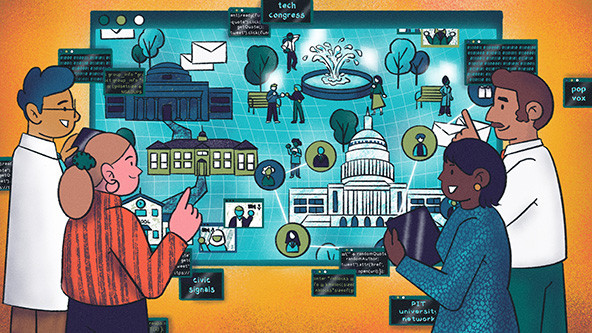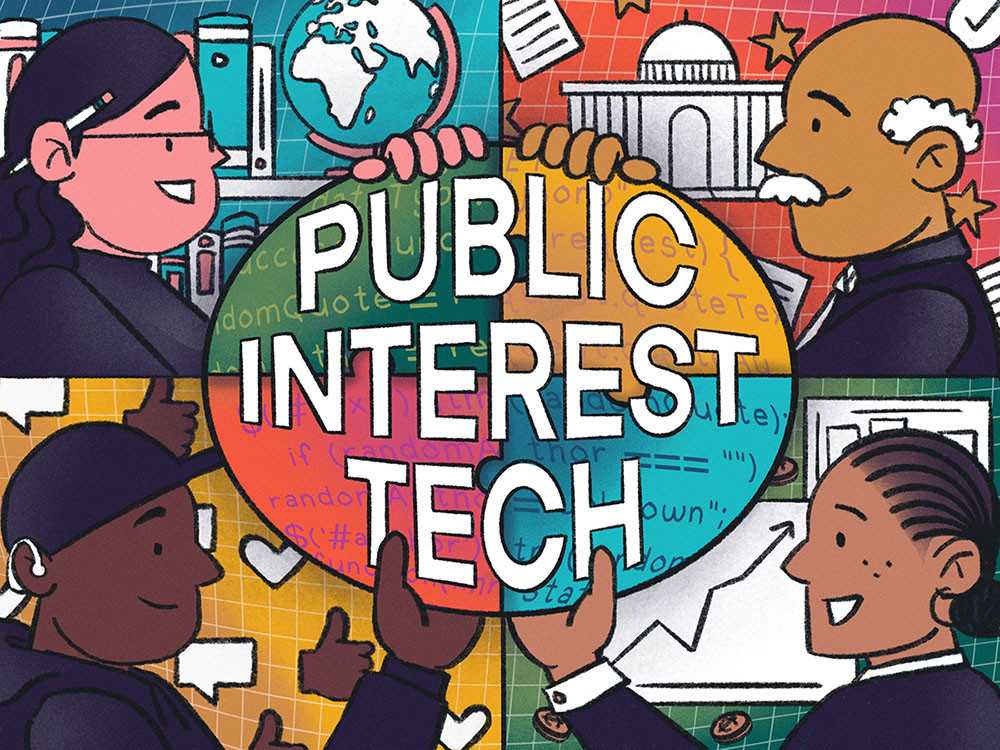 (Illustration by Vreni Stollberger)
(Illustration by Vreni Stollberger)
Right now, we have a once-in-a-generation opportunity to rebuild and reimagine America’s infrastructure systems. Following a decade of underfunding and maintenance backlogs, last year’s historic bipartisan commitment of more than $1 trillion in federal funds toward infrastructure improvements provides an extraordinary moment to modernize the systems that connect and sustain us all.
As we collectively consider how to take advantage of this window of opportunity, we need to start by redefining what infrastructure actually means. For years, the physical, digital, and social dimensions of infrastructure have been treated as separate issues—often siloed and considered in a vacuum. But in truth, then and now, the infrastructure reinforcing society is multidimensional. Each realm is heavily connected and interdependent. If we are to properly build infrastructure designed to withstand the challenges of the 21st century and beyond, we need an equally multidimensional framework for designing, funding, and governing it.

This framework absolutely must harness the ever-growing power of technology to best advance the social good. From building databases that better facilitate ethical information sharing across vital entities like hospitals and schools, to ensuring equitable access to vital services, like translating websites that offer access to benefits such as the Child Tax Credit in multiple languages – public interest technology (PIT) is a critical component of our infrastructure.
As this series of articles describes, technology developed in the public interest is designed to be equitable, inclusive, and accountable to its stakeholders, and is responsive to society’s most pressing problems. Technology is often thought of narrowly in terms of digital products and services, but it is multidimensional infrastructure that has deep social and physical impacts. Technology implies code and data, but also relies on humans to create it, engage with it, govern it, and face the consequences—good and bad—that it creates.
The reality is that technology does not default to positively impacting everyone unless we design it to do so. The more explicit we can make our expectations for technology, the more likely we are to design and wield it to achieve the outcomes we want. Furthermore, we must consider the whole design process, which spans beyond just “user experience” to also include community-centric need identification, conception, and development iteration, as well as equitable implementation, adequate maintenance, and purposeful end.
At Siegel Family Endowment, our work is centered on understanding and shaping the impact of technology on society, and supporting work that advances its use for outsized public good. Below are our visions for the PIT space and recommendations for funders who want to join us in pushing this ecosystem forward.
In the Physical Dimension, We Need People
PIT can only truly flourish if the next generation of civic changemakers is supported in their pursuit of building a better world. While still an emerging field, it’s crucial that things like fellowships, networks, and pipelines are well developed and funded in order to raise awareness of the space’s crucial role in bettering our systems, attract up-and-coming talent, and capitalize on the already great work that’s happening at the university level.
Without an increase in PIT talent, we risk stifling innovative thinking in the way society operates at its most fundamental levels. For instance, a system-wide lack of technical expertise in the government leaves companies open to misguided or ineffectual regulation by lawmakers. And while civil society organizations rightly hold a significant amount of public trust, too often they lack the technological expertise to predict where innovations are creating opportunities, compromising rights, or eroding freedoms. It is here where Public Interest Technologists can play the most important role as partners and collaborators.
At Siegel, we’ve invested in a variety of programs to grow a new generation of civic-minded technologists, who can collaborate with experts in and across different sectors, notably the PiTech Program at Cornell Tech and the Public Interest Technology University Network (PIT-UN). PiTech is building a community of PIT-focused scholars at the graduate level through Impact Fellowships, Visiting Practitioner's Program, and PiTech Studio, which brings together students from across disciplines - from engineering and information sciences, to business and law - to build products, services, and organizations that serve the public interest.
PIT-UN is a collaboration between 48 universities and colleges—from private and public institutions to HBCUs—committed to building career pathways for practitioners-in-trainings and working to recognize public interest technology as an emerging discipline. It is convened by leading foundations, including Ford Foundation, Hewlett Foundation, Mastercard Impact Fund, Mastercard Center for Inclusive Growth, Raikes Foundation, Schmidt Futures. To date, it has invested $11.6 million in projects that build a skilled and diverse pipeline of public interest technology practitioners and researchers through the development of curricula (60 new or reimagined courses), interdisciplinary research agendas (10 new PIT centers), and experiential learning programs (21 fellowships and communities of practice). Expanding the pool of talent to represent a broader range of identities allows for unique perspectives that can better illuminate gaps within the field, especially when it comes to building systems for marginalized communities.
In the Social Dimension, We Need Governance
When it comes to how communities, organizations, and public spaces shape the way people connect with each other, governance plays a crucial role. The most adept governance comes when policy makers have access to a range of experts, gather input and build consensus among those most affected, leverage data and evidence, and respond to new technologies as they become essential to societies. TechCongress, which pairs talented technologists with members of Congress and congressional committees, is an excellent example of this matchmaking between diverse tech talent and specialized policymaking. TechCongress fellows are assigned to lawmakers on both sides of the aisle, and have been involved in many high-profile tech cases, from managing the Senate Commerce Committee’s investigation into the revelations by Facebook Whistleblower Frances Haugen to organizing Congress' first hearing into facial recognition technology. Furthermore, given today’s interdependence of physical, digital, and social infrastructure, governance must be addressed by a mix of sector professionals (trained in specialized fields, such as education or health care) and technical experts (such as software engineers, data scientists, and cybersecurity professionals). This cross-sector set of stakeholders will strengthen checks and balances.
As much as we need better governance of technology, we also need better technology for governance. Public sector actors can increase efficiency by incorporating digital tools, data insights and evidence, and public input into their internal processes. However, politicians and their staff have long been unequipped to make effective use of technology in their own operations and workflow. What’s more, every congressional office is free to choose its own technology vendor, leading to a patchwork of platforms and a trove of unlinked and non-interoperable data that could otherwise be mined and leveraged for insights. All of these factors—combined with government’s niche product needs, rigorous security requirements, and opaque certification processes, make public sector technology seem like a less attractive business opportunity.
Some of these gaps are being filled by nonprofits that are focused on public-sector capacity, such as the PopVox Foundation, which ran a congressional onboarding for new members and their staffers in 2020 to share advice on things like how to set up an office and find the right staff, as well as how to best make use of technology, experts, and data to be more effective. The post-pandemic opportunity is how to incorporate more of this behavior throughout the whole of government—from constituent engagement and feedback, to policy formulation and implementation, to evaluation and refinement, to regulation and oversight.
In the Digital Dimension, We Need Options
The current landscape of companies that dominate the tech space has led to a mixed bag of success in terms of actualizing civic values. All good intentions aside, accountability to shareholders is still the driving force behind the majority of business decisions. What might it look like if that weren’t the case?
One compelling frame being put forth is that of digital public infrastructure (DPI), which can be broadly defined as infrastructures that allow us to engage in public and civic life in digital spaces. In its current form, this infrastructure largely relies on commercial technology platforms that have neither the obligation nor incentives to put civic values at their core. DPI, on the other hand, would be the digital equivalent of public parks in this internet full of shopping malls.
Ethan Zuckerman, who coined the term, has written prolifically on the topic – and organizations like New_ Public, a media project for amplifying the ongoing conversation around building better, more inclusive digital public spaces, are piloting ways to make it happen. New_ Public spent two years working with more than 100 experts and thousands of citizens in 20 countries to build a framework, called Civic Signals, to guide the design and evaluation of public-friendly platforms, which will serve as the basis of their forthcoming DPI incubator. To be clear, the goal of DPI isn’t to offer rickety alternatives to commercial platforms and rely on people’s morals to use them; the goal is to create products that rival the current paradigm because they are good products. They are valued for their utility and also because they are welcoming, plural spaces that offer safe and generative experiences. Their public interest features, such as their participatory nature, their models of platform and data governance, and their transparency, are core to their value proposition.
Private companies are often prized as the originators of “disruption,” but they’re not the sole source. Innovation comes from many places, including third-sector actors like NGOs, civil society, and philanthropic organizations. While innovating slowly, intentionally, and equitably is often less flashy to investors, it will likely come down to the work of philanthropists, impact investors, and patient capital to catalyze more research and development in the public interest to help overcome some of the financial barriers for the third sector.
Philanthropy Can Help Fuel an Ethical, Equitable Innovation Ecosystem
Today, there are an ever increasing number of real world dependencies that are evolving how critical technology is becoming as a piece of infrastructure. And if we just think of technology as digital, while ignoring its social and physical dimensions, we won’t be as equipped to steward it toward the ethical, equitable, and prosperous outcomes we want to see for all of society.
If philanthropy is society’s risk capital, funders and philanthropists have a crucial role to play by:
- Demonstrating what’s possible and fueling an innovation ecosystem that designs and builds technology with the public interest at its center. By making space for new and emerging solutions to be tested, iterated, and scaled, funders can validate publicly oriented projects and approaches to other types of investors.
- Infusing nuance into the conversation. Technology is not a monolith, but rather has contributed both positive and negative impacts on our society. The task at hand is to untangle those effects and make slow, steady progress toward enhancing the positive while mitigating the negative. Funding research that unpacks this nuance and offers new methods and frameworks for how technology is reshaping society is key.
- Investing in the next generation of public interest technologists. There are entire networks of higher-education institutions and nonprofits committed to advancing and expanding the field of public interest technology with the goal of building a more equitable future. By supporting their work, their projects, and their interest at large, we’ll be one step closer to being prepared for a more technological world.
Through our work, we strive to set examples for how out-of-the-box thinking can lead to real, tangible outcomes that result in more innovative systems that advance equity, fairness, and justice throughout our communities. Looking ahead, our hope is that continued momentum in this direction will result in meaningful outcomes for the groups and communities that need it most.
Support SSIR’s coverage of cross-sector solutions to global challenges.
Help us further the reach of innovative ideas. Donate today.
Read more stories by Katy Knight & Laura Maher.

